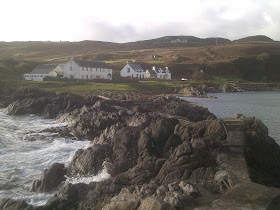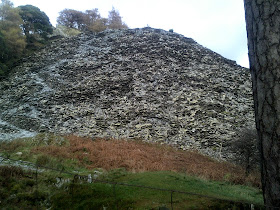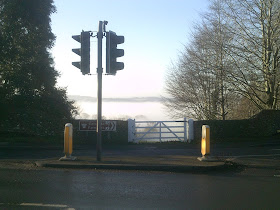Sunday, 26 November 2017
Diffuse reflection at Carraig Fhada, Islay
Two new words have appeared on the GCSE Physics syllabus - speuclar reflection is for when all reflected rays are parallel to each other and make a coherent reflection. Diffuse means that the reflection is from a rough surface. For each ray, angle of incidence = angle of reflection. Even if the incident rays go in parallel to each other they won't all have the same angle of incidence because the of the uneveness of the surface. The reflected rays will not be parallel to each other. The waves were driving in from the left in the middle picture. look how rough the profile of Carraig Fhada is. Diffuse reflection was making for a rough sea that day.
Saturday, 25 November 2017
Delezenne Circle
This is an amazing piece of equipment. The Earth's magnetic field passes through the wooden circle, which contains a big coil of wire. Flux from the Earth passes through the coil. Hence there is flux linkage - which is defined as number of turns on the coil x flux. There is a handle at the top which I managed to cut off in the photograph. If I rotate the handle, the wires spin in the flux. Imagine a quarter turn through 90 degrees from full flux linkage with all of the flux passing through the coil to a point at which the coil is parallel to the flux and no flux passes through the coil. Faraday's Law states that induced emf = change in flux linkage/time taken. An emf is a voltage which could be measured by attaching a multimeter to the contacts. Flux changes from N x flux back to zero in time delta t. Delta t is one quarter of the time period so it is T/4. So emf = 4N x flux/T. I rotate the coil at a steady rate and time 20 cycles. I then diivde by 20 to get T. Finally, the Earth's flux = emf x T/4N. If I want magnetic flux density B, then B = flux x area of the circle.
Friday, 24 November 2017
Moments and the slate wine bottle holder at Honnister
I really liked this wine bottle holder in the shop at Honister Slate Mine. It is not bolted down. It really is a balance bar obeying the principle of moments. A 75cl bottle will have a mass of 750g of wine. Let's make it up to 1kg including the glass.Centre of mass looks about 3cm from the pivot on the table top. Centre of mass of slate holder looks maybe 6cm from pivot which would give the piece of slate as 500g.
Thursday, 23 November 2017
Diffraction through the net curtain
The diffraction pattern from the neighbour's light was really clear through the net curtain this morning. I'm always amazed by how well net does diffract light. The cross shape is because there are horizontal slits in the net which diffract vertically and vertical slits which diffract horizontally.
I was struck by these things:
1. The bit minimum outside the central cross. There were lesser minima visible to the naked eye beyond.
2. I'm wondering why the central section is also slightly split. I suppose that the diffraction pattern is usually overlaid by an intensity pattern dictated by the single slit. Maybe that effect is just very pronounced here.
3. The colour split is very noticeable. Violet closest to the middle and red further out.
I was struck by these things:
1. The bit minimum outside the central cross. There were lesser minima visible to the naked eye beyond.
2. I'm wondering why the central section is also slightly split. I suppose that the diffraction pattern is usually overlaid by an intensity pattern dictated by the single slit. Maybe that effect is just very pronounced here.
3. The colour split is very noticeable. Violet closest to the middle and red further out.
Wednesday, 22 November 2017
Black Hole at Campfield Marsh RSPB
This pipe on the RSPB reserve at Campfield Marsh reminded me of a black hole. What goes in can't come out - and a bonus is that gravity is the force pulling the water over the edge. The pipe edge would be the event horizon. It is so difficult visualising a black hole - it's a 3-dimensional star but also a singularity.Imagining a hole in the air in front of me is head-wrecking.
Tuesday, 21 November 2017
Polarised zenith at sunset in Silloth
Silloth at sunset.
Then I remembered that at sunset, the sky above my head is supposed to be plane polarised. Looking at it with my eyes through polarising sunglasses, it seemed clear to me that the sky became darker as I twisted the filter through 90 degrees. I tried to photograph it. Not that convincing!
Then I remembered that at sunset, the sky above my head is supposed to be plane polarised. Looking at it with my eyes through polarising sunglasses, it seemed clear to me that the sky became darker as I twisted the filter through 90 degrees. I tried to photograph it. Not that convincing!
Sunday, 19 November 2017
Silloth amusement arcade and the Castle Crag slate heap
I love the 2p machines in amusement arcades. Here is one at Silloth. It's the way that the coins manage to build improbable structures by stacking over each other. I know that there are often bits underneath to encourage the overhangs, but even so .....
It's a kind of emergent structure. It must be possible to model it using the laws of mechanics. I was interested in the assertion below that it is not an example of complexity.
It's a kind of emergent structure. It must be possible to model it using the laws of mechanics. I was interested in the assertion below that it is not an example of complexity.
The stacked coins remind me of stacked slates in a scree. Here is an example at the former quarry at Castle Crag.
Saturday, 18 November 2017
Parabolic reflectors for giant halogen lamps
The car dealership had large halogen lamps - bigger versions of those that I used to put inside an overhead projector (OHP). And they were surrounded by parabolic silver reflectors. A parabola is the curve that you get if you plot y against x-squared. It is an important shape for a reflector because it has a clear focal point. In other words, any parallel beams of light coming in reflect back out through a single point. That is not true for a spherical reflector. Rays that are parallel are said to have come from infinity. So these lamp shades work in reverse. If you put the bulb in at the focal point, the rays that go upwards back into the lamp shade are reflected back out parallel in a beam.
Friday, 17 November 2017
Horse hair icicles on the fence
We were fascinated by these icicles that had formed around horse hairs at Campfield Marsh. Why only on the hairs but not on the barbed wire? We don't know whether they had formed on the wire but already melted. The metal of the wire is a good thermal conductor because of its delocalised electrons. It feels cold to the touch because it conducts thermal energy away from your hand. So maybe water should freeze more quickly on the wire. That might mean that ice would melt more quickly on metal than on an insulator. https://www.nuffieldfoundation.org/sites/default/files/files/Melting%20ice%20-%20merged%20PDF.pdf So perhaps that's the explanation - that there was ice on the fence but that it had melted.
Thursday, 16 November 2017
Keeping the lighthouse clock on time
I found this outside the museum at Port Charlotte on Islay. It was from a local lighthouse. The lighthouse was provided with a clock and was expected to keep regular hours. But what if the mechanism ran fast, ran slow or stopped? They were provided with a sundial to give the correct time to set the clock. When a measuring instrument gives the true value, it is said to be ACCURATE. This sundial makes the lighthouse clock accurate.
Wednesday, 15 November 2017
Strange sky over Wigton
I spotted this interesting sky at sunset. In the bottom picture the pink light from the clouds must be the colour of the sunlight left after the other colours have been scattered away by dust in the atmosphere. Then that light has been able to reflect towards me from certain stand out features on the lower surface of the clouds. The ripple marks are perhaps evidence of turbulence where air masses travelling at different speeds meet.
Tuesday, 14 November 2017
Ping-pong with static electricity
I connected the parallel plates to a potential difference of 4000V. I hung a table tennis ball between the plates on insulating thread. The ball was painted in conducting paint. The ball is touched on the negative plate. Electrons flood onto the ball and is becomes negative so it is repelled from the negative plate and attached to the positive plate. When it touches the positive plate all of the electrons are pulled from the plate. Judging by the force with which the ball is repelled back, this must include delocalised electrons from the graphite-based paint which will leave the ball depleted of electrons and thus positive. The alternative is that it ends up neutral and gravity pulls it back. I doubt that alternative because damping due to air resistance would leave it short of the negative plate. This ping-pong continues backwards and forwards, shuttling electrons one way across the gap. If the plates are closer, the frequency is much higher. Is this because the distance is less or because the field strength is higher?
Monday, 13 November 2017
Reflecting on partial reflection
I was asked a brilliant question today about why you see a lot of reflection in glass when you look from a bright place out into a dark place but not the other way round. Here's the view this evening. The lights illuminate the inside of the room so there is a lot of light heading towards the window. Some of this is reflected and we can see it. What we can't see is how much of it leaks outside. However, we can see the light from outside transmitted in. We can't see the fraction of the light from outside that hits the outside of the window and is reflected back outside. So we never see the whole picture - we see partial fractions of two different processes. The brighter one will dominate. In this case, it's the internal reflection.
Sunday, 12 November 2017
Islay ferry radar: Time period, uncertainty and sig figs
I timed the period of revolution of the larger and lower of the two radar arms as the ferry docked at Kennacraig. I timed 10 periods each time because that reduces the percentage uncertainty in the final time period. The readings were 22.87s, 22.42s and 22.69s. The mean is 22.66s. Uncertainty = 1/2range = +/- 0.225s. Percentage uncertainty = 0.225/22.66 x 100 = 0.99%. This justifies using 3 sig figs when I calculate the time period. Time period = 22.66/10 = 2.27 seconds.
Saturday, 11 November 2017
Popping the cork - Paul's last Wainwright
The weather was exciting for Paul's last Wainwright on Place Fell. Here's the Prosecco being popped. I was being asked last week about how a cork is fired from a bottle. The gas inside needs to have a higher pressure than the air outside. That's not difficult to achieve. But it also important that the difference in pressure provides a resultant force that is greater than the frictional force of the cork against the side of the bottle. The cork is wired on just in case but the cork stays in place even when the wire has been removed. It is necessary to edge the cork out slightly. By doing so, the area of contact between the cork and the glass is reduced so the overall frictional force is reduced. When the resultant force due to the pressure is greater than the friction, the cork flies off. There must come a point when the friction is reduced to zero but the resultant force is large to fire the cork a long way. The parabola was impressive! And congrats to Paul on the achievement!
Friday, 10 November 2017
Magnetic field in a solenoid
Then I turned on the current. The compasses inside the solenoid point right, along the axis of the solenoid. Those above and below point left. the conclusion is that magnetic flux goes one way through the centre of the coil and then loops back round the outside of the coil. Thus there are said to be circuits of flux flowing through.
Then I reversed the current and the magnets all dutifully pointed in the opposite direction.
Monday, 6 November 2017
Magnetic field patterns
Single magnet pattern with iron filings
Attracting poles
Repelling poles
The compasses show the direction with arrows going from north pole to south pole.Sunday, 5 November 2017
Phyllite rock layers at Kintra
The geology of Islay is very complicated. I was very taken by the twisted layers in these rocks at Kintra. Look also at the general angle of the layers in the wider picture. In the top picture, the layers seem to go through a 90 degree angle. I was hoping for an unconformity but they are all the same type of rock, just hideously twisted. The rock is called phyllite. It is a form of metamorphosed slate. I read that in slate, clay molecules line up in a preferred orientation. In phyllite it is small crystals of mica. That sounds like schist, but apparently the trick in schist is that it is larger flakes of schist that line up. My source says that the foliation (layering - from the word for leaves) is "crinkled or wavy in appearance" which indeed it is. https://en.wikipedia.org/wiki/Phyllite http://earthwise.bgs.ac.uk/index.php/Appin_Group,_Grampian_Caledonides
Friday, 3 November 2017
Radiation fog
We found this article this morning http://www.mirror.co.uk/news/uk-news/radiation-fog-descends-uk-met-11459412 It's almost like a scare story. These days the word "radiation" is synonymous with radioactivity. But radiation surely means stuff that travels in rays - ie in straight lines. The physics behind this phenomenon is that solar radiation is absorbed by the ground during the day. The ground gets a bit warmer so it radiates infra-red back upwards. It is acting as a "black body" in the technical physics definition of that term, which derives from the observation that black cans of hot water cool faster than silver cans of hot water. On cloud-free nights, the infra-red radiation is free to pass straight back out into space. So the surface of the Earth cools enough for water vapour to dip below the dew point and it then condenses into fog. Fog caused by cooling due to infra-red radiation disappearing into space.
Thursday, 2 November 2017
Looking for green at sunset over Islay
I was fortunate to see the green flash earlier in the year but have since read that it is possible to see colour separation before sunset if you project the image of the sun. I tried it here with the sun setting over Port Askaig on Islay. All I had on which to project the image was my hand. The image was inverted - you can see trees along the top of my hand. I was unable to spot colour separation along the top of the sun with this set up but will persevere.
Wednesday, 1 November 2017
AM aerial at Feolin Ferry, Jura
This is the view looking north up the Sound of Jura. Notice the thin black line going diagonally from top left of centre down and right. I took the photograph through the car windscreen. When we first bought the car, we thought that the windscreen was cracked. It turns out that the wire they use as the aerial is now discreetly hidden in the glass. Electromagnetic radio waves make electrons oscillate and that is how that are detected. The movement of the electrons constitutes an alternating current. With AM, the amplitude of a given carrier frequency is changed to mimic the voices being carried. The wire represents one quarter of a wavelength. It is about 50cm long so a wavelength would be 2m. Frequency = wave speed/wavelength = 1.5 x 10^8 or 150 Megahertz.That would make it FM though!







































